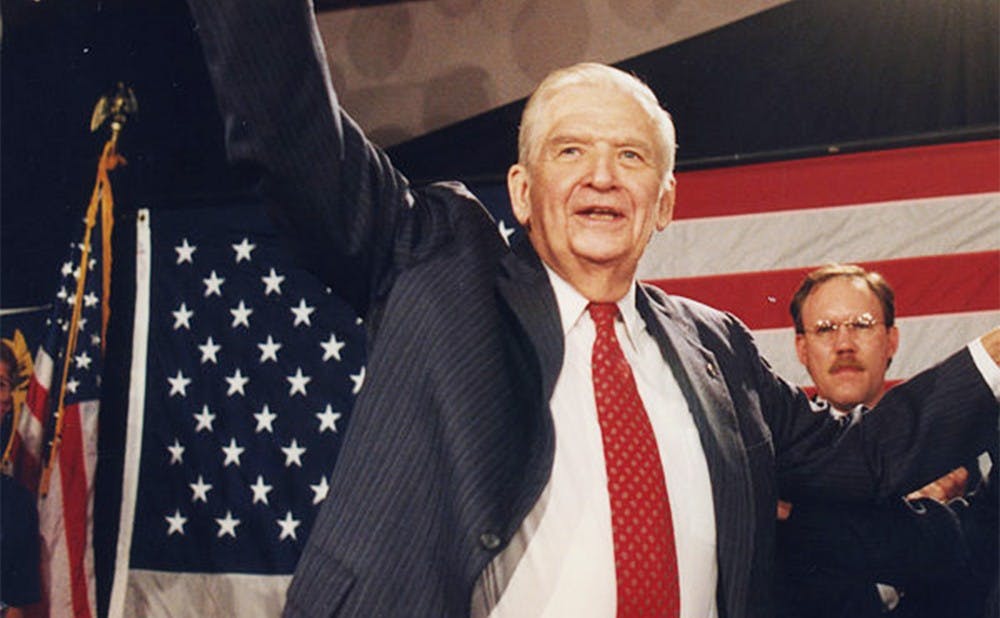As the North Carolina gubernatorial race nears its end, faculty reflected on former governor Terry Sanford's ongoing legacy in both the state and at Duke.
Sanford was president of the University for 16 years—one the longest tenures any Duke president has had—after he served as governor and Democratic U.S. Sen. for his home state of North Carolina. During his political career, Sanford pushed forward initiatives and policies that transformed the state.
“I think most historians would consider him one of the best governors in North Carolina’s history,” said Robert Korstad, professor of public policy and history.
William Chafe, Alice Mary Baldwin professor emeritus of history, expressed a similar sentiment, noting that Sanford was "probably the most important governor of the 20th century.”
Sanford’s rise in politics began with his military service during World War II, which earned him the Bronze Star and Purple Heart. When the war ended, he received his law degree from University of North Carolina at Chapel Hill and then decided to start a private law practice.
After several years at his law practice, Sanford served as a North Carolina state senator from 1953 to 1955. In 1955, Sanford chose not to run for a second term, instead looking to the 1960 N.C. governor election—which he won despite his underdog status.
As governor from 1961 to 1965, Sanford attempted to improve public education and established the North Carolina Good Neighbor Council—the precursor to today's North Carolina Human Relations Commission—to address racial relations and school integration.
“He was the first governor to embrace civil rights and to support North Carolina becoming a progressive state, willing to engage with issues such as civil rights,” Chafe said.
Often going against the tide, Sanford formed a close relationship with President John F. Kennedy—a controversial decision for the governor of a conservative state wary of Catholics. Sanford was the only Southern governor to do so, Korstad noted.
Sanford used his influence in the White House to encourage the growth of the Research Triangle Park, now an economic and technological hub. He launched what became North Carolina’s Board of Science, Technology & Innovation to help state industries apply scientific advances and technologies.
Sanford also strongly opposed the nation’s entrance into the Persian Gulf War. Calling a war in the Middle East unnecessary, Sanford insisted that the U.S. had no interest in Kuwait that was worth the lives of American troops.
Throughout his political career, Sanford emphasized education—at the time, North Carolina ranked in the bottom of all states for reading, math and science.
To improve the system of public education, Sanford raised teacher salaries and established a community college system. He also consolidated the University of North Carolina school system, initiated the Governor’s School of North Carolina for talented high schoolers and founded the North Carolina School of Arts.
But for the execution of these initiatives, Sanford left academic matters to people he appointed who were more experienced than he was, Chafe said.
When Sanford became president of Duke in 1969, students had positive views of him because of his liberal, progressive agenda.
His tenure as Duke president occurred during a tumultuous time. When students held protests against the Vietnam War, Sanford supported the students’ frustrations, but according to a 1998 Washington Post article, said, “Don't fight us. Let us all fight Washington together."
Korstad noted Sanford’s success in shaping Duke's reputation as a national leader.
“It’s hard to imagine a single president who’s had more influence in the creating of the Duke of the day,” Korstad said. “[Sanford] really transformed Duke from a really top-class, Southern, more regional university into a national and increasingly international university.”
While at Duke, Sanford also taught law and political science courses. He advocated for local growth, leading to the creation of a major performing arts center in the Triangle region. In his later years, he practiced law again and was elected to the Senate in 1986 after stepping down from his position at Duke.
During the creation of the Duke Oral History Program and the Center for Civil Rights and Race Relations, Sanford remained supportive. These programs changed Duke, allowing it to now recruit primarily black graduate students, Chafe said.
Despite his other political successes, Sanford's two presidential campaigns failed, as did his goal to create President Richard Nixon’s presidential library at Duke.
Chafe was part of the group of faculty who opposed the Nixon Library.
“What [Sanford] wanted was a monument to Richard Nixon,” Chafe said. “[The monument] would have transformed Duke and made Duke into a very different university.”
However, Sanford always engaged with students, making himself open and accessible to the people he served, Korstad said.
This year’s state gubernatorial election between incumbent Republican Pat McCrory and Democratic challenger Roy Cooper has been a close race, with a major topic of controversy being House Bill 2, signed into law by Gov. McCrory earlier this year.
"He would never have supported the HB2 regulation that McCrory did," Chafe said. "He would never have supported 99 percent of what McCrory was for.”
Cooper’s platform, which focuses on increasing teacher salaries and state funding, is more in line with Sanford's policies, Korstad added.
Sanford’s legacy is still visible today because of the progressive ideas he championed in North Carolina. Duke continues to recognize him through the Sanford School of Public Policy, which is named in his honor. After he passed away in 1998 from cancer, Sanford was buried in the Duke University Chapel.
“North Carolina has two different traditions—one is a more moderate, progressive tradition and another is more conservative, particularly on social issues and financial issues," Korstad said. "Sanford certainly represents [those] more progressive tendencies of North Carolina politics."
Get The Chronicle straight to your inbox
Signup for our weekly newsletter. Cancel at any time.

